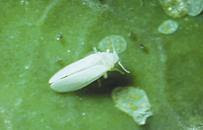Silverleaf whitefly (SLW) is a serious pest of cotton. It reduces yield and quality of cotton due to feeding damage and excretion of honey dew. It is a difficult pest to manage due to its ability to rapidly increase in numbers and the development of resistance to many insecticides.
Resistance testing for the 2007-08 season indicated no alarming results for Admiral® (pyriproxyfen) or Pegasus® (diafenthiuron) in cotton areas. The IRMS guidelines for Admiral® require that only 1 spray may be applied per season. Apart from the cost involved, more then one Admiral® spray has been shown to increase the development of resistance.
As part of the management strategy for whitefly it is important to know what species or biotypes are present as these will significantly impact on the management decision that is required. Refer to past beatsheet articles to read more on identifying the different species and biotypes of whitefly.

In Emerald, a limited number of Pegasus® sprays have been applied for SLW. Pegasus® is best used for early season suppression of SLW at low insect densities or as a late season knock down to prevent honey dew contamination of open bolls.
Very few (if any) Admiral® sprays have been applied so far this season. Admiral® may be applied after 1450 day degrees if SLW numbers reach high densities. Remember that only one Admiral® spray may be applied per season to limit the potential for resistance to develop.
In Emerald, there were high levels of natural control of whitefly from the parasitic wasps, Eretmocerus hayati and Encarsia formosa. Parasitism levels of 40% and 75% were recorded in two fields in the Emerald Irrigation Area. In a field at Biloela, parasites were so abundant that the tiny wasps were clearly visible walking around on leaves.
It is likely that the high parasitism levels recorded in Emerald and Biloela are due, in part, to very limited mirid sprays earlier in the season. This has avoided flaring SLW and allowed beneficials to multiply and offer a free service to growers and consultants in controlling whitefly.
Whitefly numbers are reportedly building up at St George/Dirranbandi. DPI&F entomologists will be visiting the area next week to collect samples for resistance monitoring and check parasitism levels.
While whitefly are definitely starting to make their presence felt in cotton fields across Queensland, their presence does not necessarily warrant action. Monitor fields often as whitefly can build up exponentially, identify what species/biotypes are present, use the available thresholds and avoid flaring whitefly by minimising the use of disruptive insecticides and maintaining beneficials in the system.
Article by Zara Ludgate

